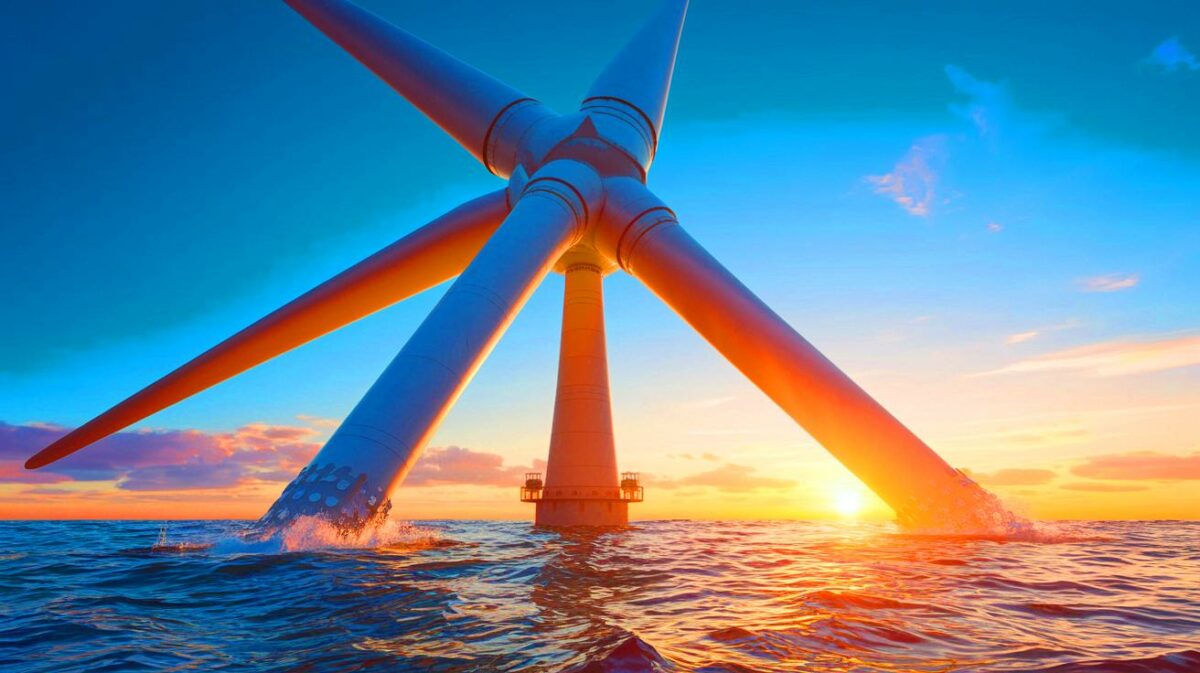| IN A NUTSHELL |
|
As the world races towards more sustainable energy solutions, China has unveiled a monumental stride forward: the world’s largest floating wind turbine, the “Qihang.” Developed by the China Railway Construction Corporation (CRRC), this 20 MW turbine is a landmark in the realm of renewable energy. With the capability to save approximately 27,500 tons of coal and reduce carbon emissions by 68,500 tons annually, the Qihang is not just about power but also a testament to innovation and sustainability. It marks a significant pivot in the exploration of ultra-large offshore wind turbines, setting the stage for future energy landscapes.
A Technological Marvel: The Largest Floating Wind Turbine
The “Qihang” turbine exemplifies a remarkable leap in renewable energy technology. Independently developed by CRRC, this 20 MW floating offshore wind turbine stands out due to its immense scale and capacity. With a rotor diameter of 853 feet, equivalent to seven football fields, it sets new standards in size and power. Its 495-foot hub further accentuates its imposing stature, making it the largest floating wind turbine globally.
Beyond its size, the Qihang impresses with its performance capabilities. The massive blades rotate at a top speed comparable to high-speed trains, with a single rotation capable of powering a household for 2 to 4 days. This underscores the turbine’s energy efficiency and its role in achieving ambitious environmental goals by conserving fossil resources and significantly cutting CO2 emissions.
In comparison, other prototypes like Envision Energy’s 16.7 MW and Dongfang Electric’s 18 MW, which began testing in 2024, are outperformed by the Qihang. Even the uniquely V-shaped Mingyang Tiancheng at 16.6 MW doesn’t rival this newcomer. This technological innovation race positions China at the forefront of the offshore wind sector, reinforcing its status as a global leader.
Overcoming Construction and Transportation Challenges
The construction and transportation of the Qihang turbine posed significant logistical and technical challenges. Manufactured in Sheyang, Jiangsu, in October 2024, the turbine was transported from Sheyang Port to Guangli Port in Dongying using a self-propelled modular transport unit. This complex process ensured the structural integrity and safe transport to the Shandong Dongying wind equipment testing and certification innovation base.
On January 11th, the turbine was installed at its test location, marking a new development phase. This crucial step is vital for validating the wind turbine’s performance in a dynamic marine environment. Engineers overcame various obstacles to ensure the Qihang’s stability, employing advanced control technologies and typhoon-resistance strategies. These innovations guarantee exceptional stability and minimal operational sway, even in extreme weather conditions.
The transport and installation process highlights the importance of modularity and component reusability in large-scale renewable energy projects. By integrating modular system interfaces and structural components, CRRC optimized the turbine’s flexibility and efficiency, paving the way for greater adaptability in future similar projects.
Environmental and Energy Impact
The environmental impact of the Qihang is significant, reducing carbon emissions and contributing to the global energy transition. By conserving about 27,500 tons of coal annually, this wind turbine significantly cuts reliance on fossil fuels, a crucial goal in combating climate change. Additionally, the reduction of 68,500 tons of CO2 per year marks a major step towards a more sustainable future.
The development of the Qihang fits into China’s broader strategy to dominate the offshore wind sector. Having already surpassed the UK as the largest installed base, China aims to extend its influence in the international market, particularly in Europe. This ambition is backed by continuous investments in research and development, with the goal of creating ever more powerful and efficient energy solutions.
Moreover, the Qihang’s potential to contribute to clean energy production comes with significant economic benefits. By lowering fossil fuel import costs and creating new job opportunities in the renewable energy sector, this wind turbine represents a major asset for the Chinese economy. The Qihang thus symbolizes a step forward towards a more resilient and sustainable economic and energy model.
Innovation and Cutting-Edge Technology
The Qihang incorporates cutting-edge technologies that provide exceptional performance and adaptability to marine conditions. Equipped with over 200 test points covering every critical aspect of the turbine—from blades to transmission chains, towers, floaters, and mooring systems—these test points collect data on three-dimensional wind conditions, waves, and the floating platform’s six degrees of freedom responses, allowing for comprehensive performance analysis.
These technological advancements ensure not only increased energy production efficiency but also optimized turbine maintenance. With a design focused on component reusability and modularity, the Qihang benefits from enhanced flexibility and efficiency. It can quickly adapt to technological changes and global energy market demands.
The typhoon-resistant strategies implemented in the turbine’s design ensure exceptional stability, even in the most extreme weather conditions. These innovations allow the Qihang to operate optimally while minimizing risks to the environment and local infrastructure. The Qihang thus positions itself as a benchmark for future offshore wind turbines, combining technological innovation and environmental respect.
China as the Global Leader in the Wind Energy Sector
With the development of the Qihang, China solidifies its position as a global leader in the wind energy sector. The country has already surpassed the UK to become the largest installed base of offshore wind turbines, and this is just the beginning of its international expansion. Chinese companies, such as CRRC and Mingyang Wind Power, are poised to make their mark on the global market, particularly in Europe, where demand for renewable energy continues to grow.
Mingyang Wind Power, for example, is developing an even more powerful 22 MW unit, set to become the most powerful floating turbine worldwide. Meanwhile, Envision Energy has secured a contract to supply 344.5 MW of wind turbines for the Quezon North wind project in the Philippines, marking the largest wind contract ever recorded in the country.
These successes reflect China’s ability to innovate and adapt to global market demands. By investing in research and development, the country ensures a technological edge that enables it to meet current and future energy challenges. China thus asserts itself as a key player in the global energy transition, paving the way for a more sustainable and environmentally friendly future.
The Qihang represents a significant advancement in renewable energy, embodying the potential of technological innovation to transform our approach to energy production. As China continues to develop increasingly powerful and sustainable energy solutions, what impact will these advancements have on the global energy balance and efforts to combat climate change?
Did you like it? 4.4/5 (25)









Wow, this is groundbreaking! Can’t wait to see how the U.S. responds. 🇨🇳💡
Why would the United States have to worry about this? This is about as real as a Peaceful Muslim.
You shoudk know there is no such thing as a peaceful Muslim.
Is this turbine really as efficient as they claim? 🤔
The worst innovation!
Depuis quand les usa s’émerveille face a la chine. Ce pays ne mérite aucun respect , ni aucune pub . surtout de la propagande chinoise infondé…
Comme leur pseudo reacteur de mach 16 qui ne va pas plus qu’a mach 2 .
Ca fait peur les pseudos journaliste
First and foremost this article was written by an AI tool. Sounds like one of my high school history reports where I was copy pasting things from an encyclopedia. 2nd this article doesn’t mention that on the first trip to set this thing up they ran into many issues and had to head back to port for repairs and fixes. 3rd they have no idea how this thing is going to stand up to a typhoon until it goes through a tycoon. Cue clip of Tycoma Narrows Bridge please. And lastly this monstrosity isn’t operating yet at all and those power outputs are way liberal estimates. That makes concessions that this thing never has down time for maintenance or anything else. Extreme whether where it has to stop operating. I think this eventually is going to become a huge embarrassment for the Chinese.
Entièrement d’accord. Propagande chinoise écrite par un outil IA. Où sont les images ? L’ironie quand on sait que la Chine est un des plus grands pollueurs de la planète, et vient donner des leçons en énergies renouvelables.
Another crappy AI article skimming information and regurgitating it three ways, all with great hyperbole. These bots are far from taking over and the publisher, invented a month ago, just another arm of the Chinese PP. Tiresome.
Thank you for the detailed article. Very informative! 🌍
How long did it take to develop this technology?
So when do we get to see this “Qihang” in action? 🚀
Impressive feat by China, but can this be replicated elsewhere?
Are there any environmental concerns with such large turbines?
How does this compare to other renewable energy sources?
Great read! The engineering challenges must have been immense. 🛠️
How much does it cost to build one of these giants?
Seems like sci-fi turned reality. Amazing! 🌟
How reliable are floating wind turbines compared to fixed ones?
Isn’t 20 MW a bit overkill? 🤨
Looks like the U.S. has some catching up to do! 🇺🇸
Exciting times for renewable energy enthusiasts! 🌿
What are the maintenance challenges for such large turbines?
Why does China always seem to be one step ahead in technology?
Because of massive industrialized IP theft.
20 MW? That’s insane! Can it really produce that much power?
Hopefully, this leads to more global cooperation in clean energy.
Thank goodness for technological advancements like these! 🌞
How will this affect local ecosystems? Any studies on that?
This could be a game changer in the fight against climate change!
Are there any plans to export this technology?
China is really leading the way in renewables. Impressive. 👏
When will we see similar projects in other parts of the world?
How does this impact the global wind energy market?
Why was it necessary to make it float? Just curious.
The engineering behind this must be mind-blowing! 😮
Wow, China is really making strides in renewable energy! 🌏
Is this the future of wind energy? Looks promising! 🌬️
Quite a lot of bots commenting on a “renewable energy” article…
Sounds like baloney. Show a photograph, not an AI creation.
Sorry, it’s real. The drawing is just fake. Guess author could not get permission for a photo.
Why don’t you say something about the Hoover Dam in the U.S. of America and all the other dams all over that dammed country ? They have existed long before the 3 Gorges Dam, and they have affected the earth for a much longer time. Why don’t you say something about the fact that the US of A is the only country that has deployed 2 nuclear weapons on the civilians of another country with devastating effects on the victims and the environment even up to now. The US government is the one who doesn’t give a dam about the welfare of all the people in the world, including its own citizens.
To compete with China America is adding tofu to steel beams to make them edible
There isn’t even a real photograph on this thing to prove that this even exists. What is here is just an illustration.
It’s CRCC … not CRRC